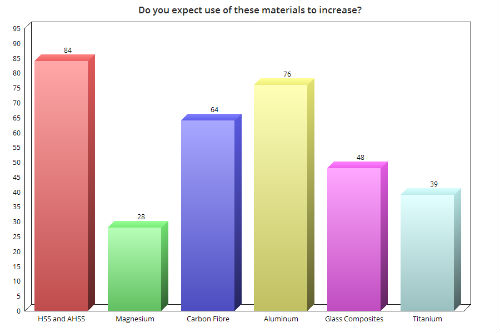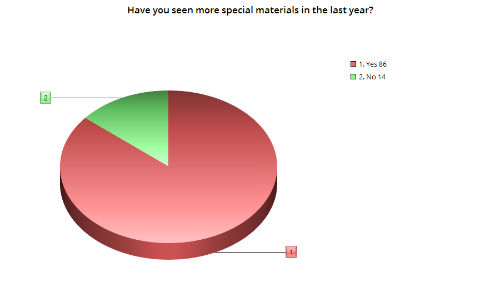By Mike Davey
Hamilton, Ontario — March 14, 2017 — We’ve seen a wealth of advanced materials in vehicle construction in recent years. Will this trend continue? The results of our latest opinion poll indicate that collision repairers certainly expect it to.
Our most recent survey asked repairers to provide their opinions on these special materials. Our next survey focuses on consolidation, both within collision repair itself and throughout the broader auto claims economy. You can participate in that survey at this link.
It should be noted that this survey represents only the opinions of its participants. These are the opinions of some members of Canada’s collision repair industry, not that of automotive designers or OEM executives.
The first question in the special materials survey asked whether or not respondents expected to see more lightweight materials, such as aluminum, magnesium, etc. Over 96 percent of respondents indicated that they thought this trend would continue. However, a comment left by one respondent illuminates a factor that could easily change this trend. As always, comments are presented anonymously, with only minimal editing:
“If the new American government reduces fuel efficiency law, then manufacturing will reduce special material investment. It’s always about the money.”
It’s hard to argue with that. Manufacturers have largely been forced to turn to special materials to reduce weight, essentially because they must hit certain standards. If those standards change, the drive to lightweighting within the North American vehicle will almost certainly change along with it.
The next question asked respondents to let us know if they’ve seen more of these materials in the vehicles that have come into their shops in the last year. The majority (86 percent) had, but 14 percent had not.
When it comes to estimating, about 65 percent of our respondents assign different labour times to different materials. This leaves 35 percent of respondents indicating that they do not do this. It looks like this an area where the industry could get on the same page.
The next round of questions asked respondents to indicate whether they thought the use of a particular material would increase, decrease or stay the same.
 |
|
| The majority of our respondents expect to see more HSS, AHSS, carbon fibre {source}<br/>{/source}and aluminum used in vehicles. |
The first question in this category dealt with high-strength steel (HSS) and advanced high-strength steel (AHSS). These materials certainly aren’t new, but it seems like their use has increased in recent years as the OEMs seek more ways to lighten vehicles. A majority of respondents (84 percent) expect this trend to continue, with more HSS and AHSS appearing in vehicle designs. However, 7 percent of our respondents expect its use will decrease, while 9 percent believe it will stay roughly the same.
Next, we looked at magnesium. This material isn’t common now, and most of our respondents (48 percent) don’t expect that to change. A further 28 percent believe it will increase, while 24 percent believe its use will decrease.
Magnesium is somewhat tricky. As some of our commentors pointed out, it’s very expensive, which would naturally limit its use. However, another commentor reminded us that the OEMs can often make surprising decisions:
“Hard to say. I did not think that any manufacturer would use magnesium as part of their tailgate structure, however FCA decided to go that route in the new Pacifica. I believe the jury is still out on magnesium at this stage.”
The next question asked readers for their opinions on carbon fibre. One commentor summed up the main challenges with increasing use of this material: “Very experimental, costs for production are too high , repair will lead to more write-offs.”
That may be so for now, but the costs of production are coming down. There are a lot of industries that could use cheaply available carbon fibre, not just automotive. This is helping to push forward research and development. It should also be noted that this comment was left before news broke that Magna has recently designed a carbon fibre subframe concept for Ford. For more on this, please see “Magna creates carbon fibre subframe for Ford.”
Challenges aside, 64 percent of our respondents expect to see more carbon fibre in coming years. Only six percent expect to see its use decrease, while 29 percent expect it to stay the same.
The next question looked into opinions regarding the use of aluminum. This is harder to predict than might be thought at first. A lot of stock market analysts were expecting aluminum to climb in recent years, as more and more OEMs started using more of the material. While we’ve seen increased use, it was not at the predicted levels. Some of the comments left on this question pointed out that there’s lots of aluminum ore on the planet right now and it’s cheaper to extract than some other lightweight materials. It’s certainly not cheap, but it’s economical compared with some of the more exotic materials, such as carbon fibre composites.
However, one commentor believes that aluminum is not the way to go, as “… aluminum vehicles will have a shorter life span than conventional ones. Corrosion with steel bolts, nuts and rivets, along with accelerated corrosion when exposed to the elements (i.e., deep scratches, stone chips) will reduce that vehicle’s life and increase repair time and cost.”
Nevertheless, 76 percent of respondents expect the use of aluminum to increase, while only 8 percent expect it to decrease. About 16 percent of respondents expect it to stay the same.
Glass composites had one of the lowest ratings when it came to respondents who expected its use to increase. While 48 percent think we’ll see more, nearly the same number of respondents (40 percent) expect its use to stay the same (in other words, they expect it to remain relatively rare). A comment sums up the reasoning for this: “Failure rate in the past is too high , repair technology has been inadequate in the past. Will require huge advancement in the substrate, or be deemed replace only, driving up repair costs and write-offs.”
Finally, our survey looked at the use of titanium. This was actually the only question where more respondents (57 percent) thought its use would stay roughly the same as it is now. Titanium is rare and they expect it to remain so. However, 39 percent of respondents do expect it will increase at some point, while only 4 percent expect its use to increase.
Collision Repair magazine’s next survey looks at consolidation within the collision repair industry, and seeks to answer if it’s been good or bad for the industry and motorists. You can participate in that survey here, and watch for results next Wednesday on collisionrepairmag.com!





































